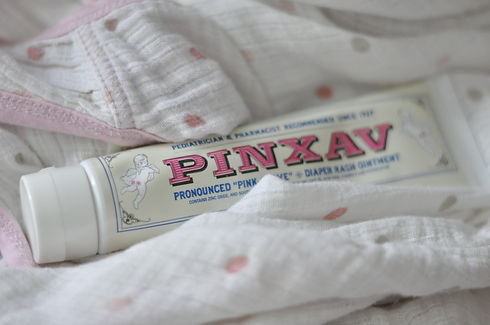P R O N O U N C E D " P I N K S A L V E "

soothe. heal. protect.


TREATMENT & PREVENTION TIPS FOR NEW PARENTS
By Lillian Harris- Original CEO of Pinxav
Tip 1:
As a new parent, you will get plenty of practice changing diapers. Your first diaper change may make you feel like running for the hills, but it really is quite simple. Once you get the hang of it you may even grow to enjoy this important bonding experience.
But be prepared—Each baby has his own attitude about the whole experience: Some will lie still, some will wiggle, some will kick and scream. Most will do all three.
Tips to make diaper changing a breeze:
Make sure you have everything you need accessible on the changing table or in the diaper bag:
• Diapers
• Pinxav
• Baby wipes or damp wash cloth
• Change of clothes
• A toy to keep your baby occupied
• Disposable garbage bag for diaper waste
Note: Prior to diaper changing, wash and dry your hands thoroughly and be sure to remove jewelry that can scratch your baby’s delicate skin.
Tip 2:
Place a towel, mat or changing cloth over the table. Lay a fresh diaper on covered surface. Never leave your baby unattended on a changing table. Always keep one hand on the baby.
Place your baby (tummy side up) on the changing table or appropriate surface that allows you and your baby to be comfortable and safe.
After removing the diaper, clean the diaper area thoroughly with a moist wipe. Hold your baby’s feet together and very gently lift them up, raising the baby’s bottom.
Wipe your baby’s buttocks and genitals gently from front to back with baby wipes. Don’t forget the lower back and the skin folds of the thighs. (A baby girl might get stool around her labia and vagina, so clean that area gently with baby wipes.) With boys, watch out.
To avoid being splashed if your baby boy starts to urinate while you’re diapering him, place a soft cloth over his penis until you can get the diaper positioned correctly. It doesn’t just happen in the movies.
Tip 3:
Blot dry, don’t rub. Carefully and gently dry between skin folds and creases.
To help prevent diaper rash, let your baby’s bottom air dry.
Apply Pinxav liberally to the diaper area to help prevent diaper rash.
Open diaper, put baby’s bottom gently into diaper.
Tip 4:
During this time you can play games like peek-a-boo, Twinkle, Twinkle Little Star and This Little Piggy, or you can sing songs and enjoy this special moment that doesn’t last long in a child’s life. Your job can be made much easier if you can keep the baby entertained long enough to keep still while you do the changing. Think of it as a mini show. Either you or someone else can create the diversion, or a mobile above might also do the trick. A stuffed toy within sight can help, or perhaps a toy when the baby gets bigger. But keep the changing accessories out of baby’s reach — and thus out of his or her mouth.
Tip 5:
Wash and clean the changing table. Wash your hands. That’s it! You survived. You can now inhale again.
Note: Make sure to pack a tube of Pinxav in your Diaper travel bag and keep a tube next to the bathing area as well. Baby bottoms are best protected when Pinxav is used with every diaper change. But if you decide to use Pinxav only once a day, make sure it’s at bedtime, when babies are more likely to have prolonged contact with a wet, rash-provoking diaper.
After approximately 6,000 diaper changes in your baby’s early years, you’ll have potty training to look forward to. But don’t fret, there’s Milford junior. If he could make it, so can you.


